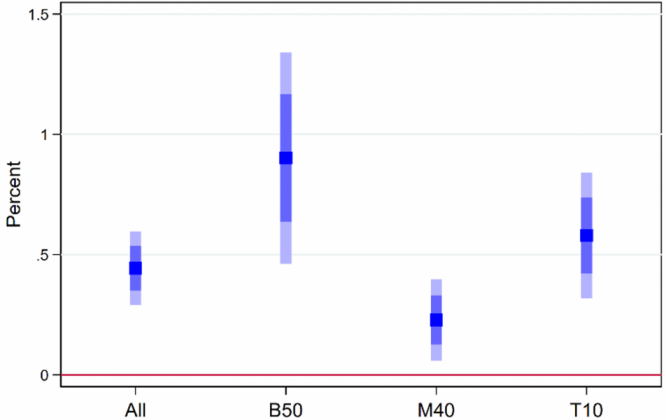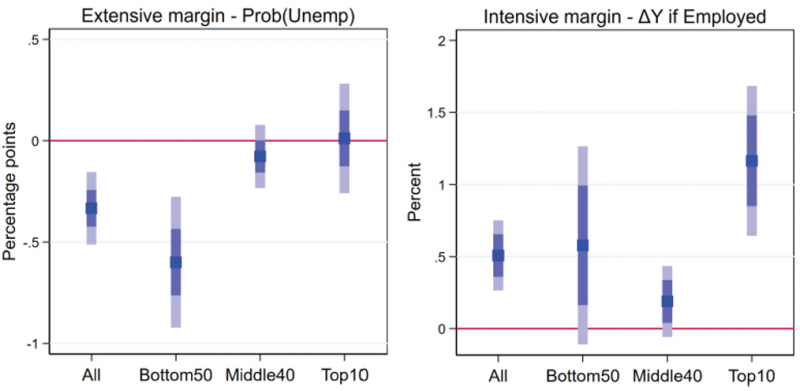

This Policy Brief is based on Banque de France Working Paper #913. Working Papers reflect the opinions of the authors and do not necessarily express the views of the Banque de France.
Using French matched administrative-survey data, we quantify the distributional effects of monetary policy on labor income and decompose the extensive and intensive margins of these effects. We find that the effects of ECB monetary policy shocks on labor income are U-shaped along the labor income distribution. These effects are driven by the extensive margin (transitions out or to unemployment) at the bottom of the distribution and by the intensive margin (labor income changes for individuals continuously employed) at the top. We document that sectoral heterogeneity, especially related to the labor force composition, is crucial in explaining these heterogeneous effects.
The prolonged period of low policy interest rates, large-scale asset purchases and the recent inflationary shock raised concerns about higher inequality and the distributional effects of monetary policy. These topics were highlighted by Jerome Powell at Jackson Hole in 2020 through the strategy of “maximum employment as broad-based and inclusive goal”. The cost-benefit analysis of such a policy (higher inflation for longer vs. tighter labor market for longer) depends on the ability of monetary policy to affect transitions to employment and wage growth at the bottom of the distribution. Does the effect of monetary policy on the extensive and intensive margins of labor income differ across households? To answer this question, we use matched administrative-survey individual data to disentangle the distributional effects of monetary policy on transitions from/to unemployment (the extensive margin) and on labor income changes for individuals continuously employed (the intensive margin).
A growing literature based on Heterogeneous-Agents New Keynesian (HANK) models shows that monetary policy has heterogeneous effects on different groups of households. The question of the distributional effects monetary policy along the distribution of total income is still open to debate as the overall effect can be driven by either labor or capital income differently along the distribution (see Amberg et al. (2022) and Andersen et al. (2022)). The heterogeneous effects on capital income reflect differences in the wealth-holding distribution and relates to the income composition channel. Instead, we focus on the earnings heterogeneity channel, directly related to labor market dynamics. The fact that monetary policy may not affect all individuals in the labor market the same way is important to assess its welfare effects and for understanding its transmission mechanisms. Documenting the extensive and intensive margins of labor income provides new insights on the consequences of heterogeneous exposure to earnings risks (Guvenen et al. (2017)) in relation to monetary policy and may inform the quantitative analysis of HANK models.
To do so, in Hubert and Savignac (2023), we take advantage of matched administrative-survey data for France, the Statistiques sur les Ressources et Conditions de Vie (SRCV), which is produced by the national statistical institute (INSEE). SRCV combines individual-level detailed administrative income tax data with survey-based information about labor market status, the number of months employed each year, job characteristics and demographics. The survey dimension of this annual panel dataset enables us to investigate labor market transitions above and beyond labor income changes only. Our sample covers 2007 to 2019. To measure the causal effect of monetary policy, we use the ECB monetary policy shock series constructed by Jarocinski and Karadi (2020) that uses a high-frequency identification strategy and adjusts monetary surprises for central bank information effects.
We find that the effect of an expansionary monetary policy shock on labor income exhibits a U-shaped pattern across the labor income distribution (Figure 1). A 10 basis points (bp) expansionary monetary policy shock increases the labor income by 0.9% for the Bottom 50% and by 0.6% for the Top 10% of the labor income distribution over one year, while the effect is more limited on the middle of the distribution. The strong positive effect in the bottom of the distribution is consistent with previous evidence obtained by Amberg et al. (2022) for Sweden or Broer et al. (2022) for Germany. However, the sizeable effects on labor income at the top of the distribution are new and not evidenced in previous studies. There are various reasons related to the data and empirical settings used, but also to individual and firm behavior, sectoral composition, and institutional settings that may explain such differences across countries.
Figure 1: Monetary policy effects: Change in labor income, in % of each group’s average labor income

Note: The monetary policy (MP) shock is the annual cumulative sum of meeting-level pure monetary policy shocks of Jarocinski and Karadi (2020) normalised to one standard deviation. An increase in this variable corresponds to an expansionary monetary policy equivalent to a 10 basis points decrease in the policy stance. Sample period: 2007-2019. Shaded bars corresponds to 1 and 2 SE confidence intervals.
What are the consequences for labor income inequality of the heterogeneous impact of monetary policy? To address this question, we perform some simulation exercises based on our estimates (Table 1). The expansionary monetary policy increases overall labor income inequality both in terms of Gini coefficient and of the share of labor income held by the Top 10%. It also increases, to a lesser extent, the Bottom 50% income share while it reduces the income share of the Middle 40%. As a result, the increase in overall inequality is also associated with a decrease in bottom inequality.
Table 1: Implications for standard measures of inequality

Note: simulated labor income based on estimates of Figure 1. SRCV data (sample period 2007-2019).
In Hubert and Savignac (2023), we provide new original evidence regarding the transmission channels of the heterogeneous effects of monetary policy to labor income. We find that the U-shaped pattern of monetary policy effects on labor income is driven by the extensive margin at the bottom of the distribution but by the intensive margin at the top (Figure 2).
Regarding the extensive margin, we find that a 1 SD expansionary monetary policy shock (equivalent to 10 bp) lowers the unemployment transition probability after one year by 0.6 percentage points for individuals in the Bottom 50% of the labor income distribution, while it has no significant impact on the unemployment probability of people with higher labor income. When looking in more details at labor market transitions, we find that the monetary policy shocks significantly decreases the employment-to-unemployment transition probability and increases the unemployment-to-employment transition probability. Such results are in line with Faia et al. (2022) who find that contractionary policy leads bottom earners to exit the labor market by more and to have lower re-employment probabilities in the U.S and with Broer et al. (2022) who find that job loss is more countercyclical for lower-earnings households in Germany.
Among individuals continuously employed (intensive margin), expansionary monetary policy has a significant positive effect on labor income only for the top earners: an exogenous 10 bp decrease in the monetary policy stance increases by about 1.2% the labor income of the Top 10% earners. Focusing on the intensive margin of labor supply, Cantore et al. (2023) find that labor income is procyclical at the bottom of the distribution because although hours worked are countercyclical for bottom earners, hourly wages respond more than hours worked. Such an intensive margin effect for bottom earners is not observed in Figure 2: the fact that labor income is procyclical at the bottom stems from the extensive margin in our empirical analysis. The specific role played by wage bargaining institutions in France, including minimum wage regulations, may be a potential reason for the different findings at the bottom of the distribution (Gautier et al. (2022)).
Figure 2: Monetary policy effects on the extensive and intensive margins of labor income, by income group

Note: estimates based on SRCV data (sample period 2007-2019). The monetary policy (MP) shock is the annual cumulative sum of meeting-level pure monetary policy shocks of Jarocinski and Karadi (2020) normalised to one standard deviation. An increase in this variable corresponds to an expansionary monetary policy equivalent to a 10 basis points decrease in the policy stance.
Hubert and Savignac (2023) also show the crucial role played by sectoral heterogeneity in explaining the distributional effects of monetary policy on labor income. Cross-sectoral differences in the effect of monetary policy shocks are large for both the intensive and extensive margins. Moreover, the effects of monetary policy on labor income are more pronounced in sectors with high levels of capital intensity or of leverage, suggesting that the sensitivity to monetary policy of a given sector explains its impact on labor income. The effects of monetary policy are also more pronounced where the procyclicality of labor income is higher: in the bottom of the distribution in sectors with high shares of flexible contracts or of blue-collar workers in the labor force, and at the top of the distribution in sectors with more permanent contracts and executive or managers where variable pay such as bonuses should be more important.
***
Regarding monetary policy, the findings of this paper have two implications. First, the heterogeneity of labor income responses across sectors suggests differentiated impacts in firms’ marginal costs, so potential different price-setting dynamics across sectors. Second, the distributional effects of monetary policy may generate an amplification mechanism through its impact on aggregate consumption as individuals more likely to be financially constrained and with larger propensities to consume are the most affected. Distributional monetary policy effects might therefore have aggregate implications beyond inequality issues.
AMBERG, N., T. JANSSON, M. KLEIN, AND A. R. PICCO (2022): “Five Facts about the Distributional Income Effects of Monetary Policy Shocks,” American Economic Review: Insights, 4, 289–304.
ANDERSEN, A. L., N. JOHANNESEN, M. JORGENSEN, AND J.-L. PEYDRO (2022): “Monetary Policy and Inequality,” CEBI Working Paper, 09/22.
BROER, T., J. KRAMER, AND K. MITMAN (2022): “The Curious Incidence of Monetary Policy Across the Income Distribution,” CEPR Discussion Paper, 17589.
CANTORE, C., F. FERRONI, H. MUMTAZ, AND A. THEOPHILOPOULOU (2023): “A Tail of Labor Supply and a Tale of Monetary Policy,” CFM Discussion Paper, CFM DP2023-08.
FAIA, E., M. KUDLYAK, E. SHABALINA, AND D. WICZER (2022): “Monetary policy and wage inequality: the labour mobility channel,” CEPR Discussion Paper, No. 17741.
GUVENEN, F., S. SCHULHOFER-WOHL, J. SONG, AND M. YOGO (2017): “Worker betas: Five facts about systematic earnings risk,” American Economic Review, 107, 398–403.
HUBERT P., AND F. SAVIGNAC (2023): “Monetary Policy and Labor Income Inequality: the Role of Extensive and Intensive Margins”, CEPR Discussion Paper 18130, Banque de France Working Paper 913.
GAUTIER, E., S. ROUX, AND M. CASTILLO (2022): “How do wage setting institutions affect wage rigidity? Evidence from French micro data,” Labour Economics, 78, 102232.
JAROCINSKI, M. AND P. KARADI (2020):“Deconstructing Monetary Policy Surprises — The Role of Information Shocks,” American Economic Journal: Macroeconomics, 12, 1–43.